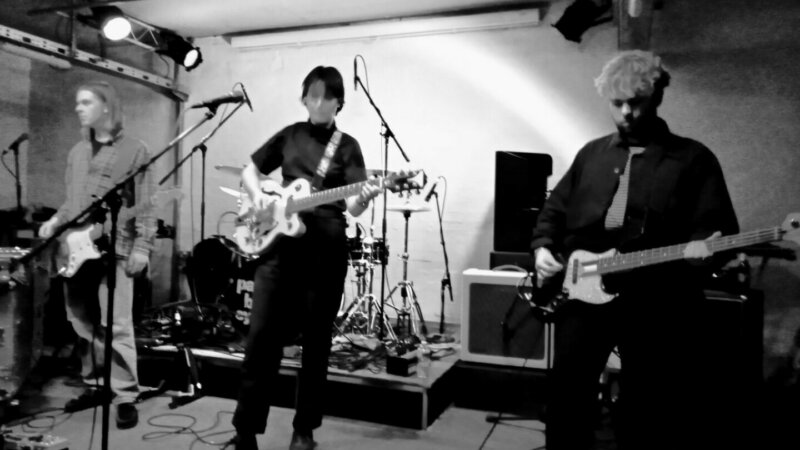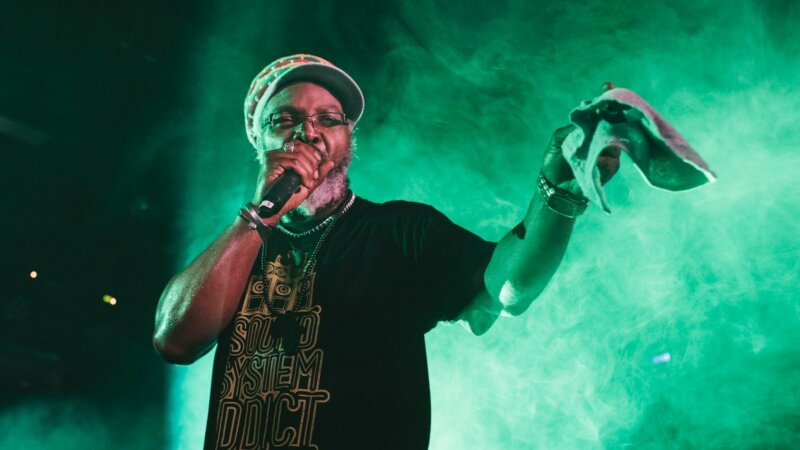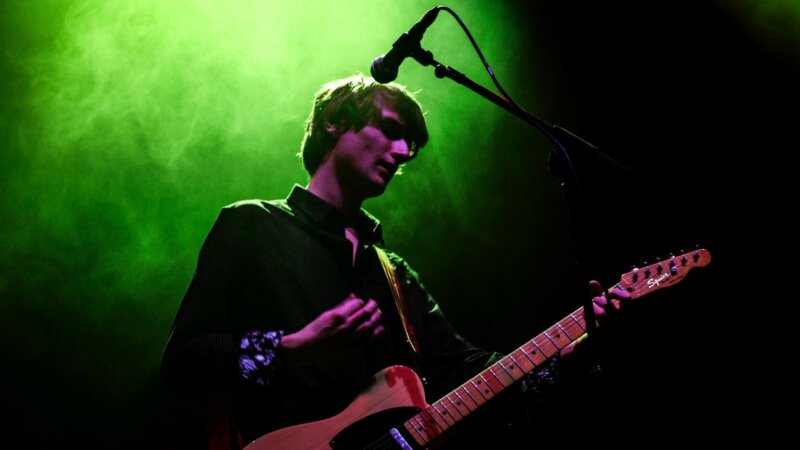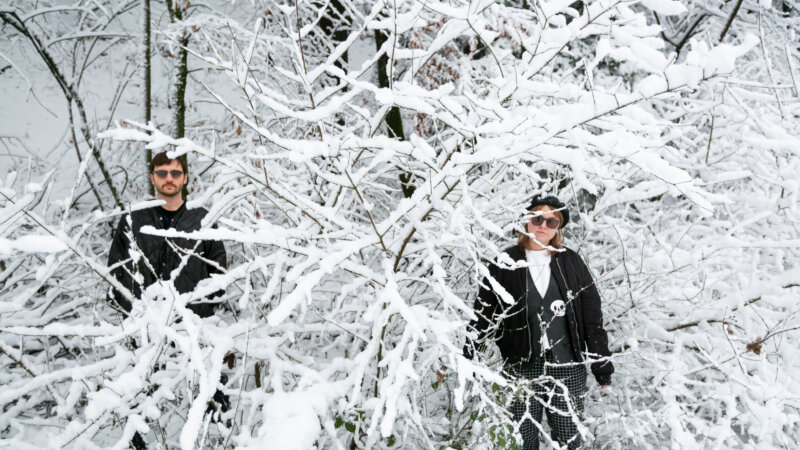Factory Floor / Jaako Eino Kalevi
2 October
Abbeydale Picture House
The dark, decaying, spacious Abbeydale Picture House was the perfect setting for the penultimate evening of this year's Sensoria Festival. The double header of LoneLady and Factory Floor on paper looked quite a match. With paint peeling off the walls, the pops, bleeps and crackles at times gave the night a nod to years gone by.
LoneLady kicked off proceedings, playing through her 2015 Warp album, Hinterland, locking basslines, guitar licks and grooves with looks in opposite directions to post-punk and 80s pop. I spent the entire set wracking my brain to think who, in her live guise, Julie Ann Campbell’s voice and sound reminded me of. As friends concurred, there was a strong whiff of Green Gartside, 80s blue-eyed soul popster of Scritti Politti. Not a bad thing. Given the average age of the crowd, I'm sure I wasn’t the only one there digging into the recesses of their memory to come to such a conclusion.
Factory Floor removed any remnants of what had gone before from the start. The duo gave a stripped-down performance, with Nik Colk Void and Gabriel Gurnsey encamped behind a wall of analogue kit, side by side, facing the crowd, without a guitar or drum kit in sight. Their set was one long amalgamation of tracks that was relentless and unforgiving.
With scratchy, atmospheric visuals projected onto a large background, Factory Floor stripped back their sound to match the venue’s minimalist apparel. The set was built around the kick and snare, clearly paying homage to the early Chicago warehouse scene and the uber-techno clubs of Europe.
The Picture House has hosted countless cinema, music and theatre nights, but this felt like what it was truly made for. Complete with its original sloping floor, it could be a serious contender for South Yorkshire's prime live venue.
Andrew Tattersall
|
1 October
Bungalow & Bears
The moment Jack from the opening act, Blessa, touched a string on his bass guitar, it was obvious that the night brought together by Semi Detached was going to be something special. Blessa went on to deliver a refreshingly consistent performance that set a different tone to what Jaakko Eino Kalevi later established once he and his drummer, Henry, graced the stage.
Jaakko’s opening track was a calm intro that allowed the two-man performance to take the reins behind the audience’s attention and guide them through the futuristic but strangely contemporary sounds that would follow. The outline of a house projected onto the wall behind him was a variety of colours that reflected the unpredictable atmosphere of the performance. His music changed from space rock to upbeat electronica to create something which has elsewhere been described as 'dream pop'.
Hearing the instruments behind Jaakko’s music live, in particular Henry’s drumming, which at times was trance-like and gentle, had an effect more significant than that of the former tram driver’s vocals. Despite the vibrating echo Jaakko applies to his voice, it was still the beat of his music that brought his performance to life, and some of the most impressive moments happened when he sung the least and allowed the mesh of electronic and instrumental music to cement his sound.
His performance covered a wide spectrum, delivering a variety of sounds that were all within the bounds of the impressive artistic space he has continued to expand.
Akeem Balogun
|
23-25 October
Various venues
The inaugural Classical Weekend marked a truly exciting new addition to Sheffield’s diverse festival calendar. Covering a wide range of traditional and contemporary music, the programme showcased local musicians and the city’s wealth of choirs alongside touring guests. With most events around 30-45 minutes long, lots of them for just a fiver or free (all completely free to under 18s), it was about as accessibly presented and welcoming as classical music gets.
In a packed Cathedral on Saturday lunchtime, Hallam Sinfonia, Tideswell Singers and the Hallam Choral Society joined together to perform Leonard Bernstein’s 'Chichester Psalms', their backdrop the tall windows of the west end, behind which autumn leaves fell and sparrows flew. It was an impressive performance of a fantastic, complex and thrilling piece of music, the occasional moments of heartbreaking melody nestled amid dark strings and wild percussion. The little lad next to me was so startled by the opening cymbal crash that he kept his fingers in his ears for the entire half an hour.
Over in the City Hall Ballroom, Sheffield Philharmonic Chorus (all 120 of them) performed Arvo Part’s 'Magnificat', the spirituals from Michael Tippet’s 'Child Of Our Time' and John Tavener’s 'Svyati'. As one body, with some collective intakes of breath that sucked half the air from the room, they were marvellous to behold, skull-shakingly loud when they wanted to be but so measured and moving, with a tear-jerking soprano solo in 'Steal Away'.
Back in the Cathedral, local composers Platform 4 debuted four pieces of new music inspired by the moon, wild walks and swooping birds. A highlight was Jenny Jackson’s 'Lament', a mournful aural mirage that played with our perceptions of listening whilst simultaneously being very listenable. Notes continued elsewhere when the lone cellist onstage had stopped playing them. The music was coming from behind us too. A wonderful use of the Cathedral space, it also highlighted the importance of attending live music events. In another venue or on record, this would have been a completely different experience.
Nat Loftus
|
30 September
City Hall
For those who haven’t seen it, La Haine, directed by Mathieu Kassovitz and starring Vincent Cassel in his breakthrough role, is an exquisitely shot, black-and-white cinematic portrayal of life in a Parisian banlieue in the aftermath of a riot, framed through the eyes of three young, multi-ethnic friends. Ever since its release in 1995, it has been upheld as a powerful representation of cultural conflict, social alienation and anti-police tension, themes that continue to make it as relevant in the year of its 20th anniversary as when it first hit cinemas.
Asian Dub Foundation have proved no strangers to tackling such issues themselves over their long and illustrious career, with one of their best-known songs, ‘Fortress Europe’, an attack on European immigration policy that could hardly fail to be more pertinent amongst 2015’s critical state of population upheaval. The group have forged an identity around a blistering fusion of punk, rap, electronic beats and bhangra, and the intensity of their live rescoring of Kassovitz’s classic adds a thick wave of heightened tension and paranoia to the imagery.
There are a couple of occasions when La Haine’s original soundtrack is missed, in particular during the scene where a neighbourhood DJ turns his speakers to the streets outside, cutting together Edith Piaf with Cut Killer’s ‘Nique La Police’, featuring the "Woop woop! That’s the sound of the police" sample. The original encapsulates the discord between the old, idyllic France and its angry, present-day self in a way that ADF’s reinterpretation doesn’t touch upon. But moments when the original score is noticeable by its absence are few and far between, and as the closing credits flicker to an end and the house lights flicker on, the roar of the audience’s applause echoing around the City Hall pays tribute to an engrossing and highly impressive undertaking.
Jack Scourfield
|
23 October
Yellow Arch
RiteTrax is billed as “a positive platform to showcase outstanding new artistic output”, and as such their launch party at Yellow Arch took a Blue Peter approach to a night out, with bands, spoken word performances and live graffiti and painting supplementing the usual DJ sets. Highlights included two groups from Golden Harvest, Soundland and Riders, who both create modern synth-based pop that utilises bang-up-to-date experimental sounds, the latter making heavy use of a vocoder aesthetic.
Out in the busy courtyard, a succession of MCs sang Sheffield's praises over and over (the way it should be, of course) to a soundtrack of deftly mixed jungle. The best atmosphere was saved for the intimate Rave Cave, partly thanks to the crystal-clear sound. As ever, the boys from Nice Like Rice could be relied upon to serve up some bangers, before Emily J & Omith performed a set of drum'n'bass fused with live flute and guitar. The criminally underexposed Bozzwell later razed the tiny room with a set of shuddering and brutal techno.
Though the selections were great, some of the programming decisions felt odd. Alternating between DJs and live acts all night caused the vibe in both rooms to ebb and flow, and it would have worked better to front-load the live acts to give the night a smoother progression. The spoken word performers also had to battle against stray kick drums and bass leaking from other rooms, making it difficult to concentrate on their words.
Variety is welcome, but I was left wondering how many people wanted to hear poetry or watch artists create abstract canvasses on a night that ran until 5am. Despite this, Yellow Arch seems a natural fit for RiteTrax, with its living room warmth and warren-like maze of little spaces. Whether they'll continue trying to be all things to all people or focus in on one of the half-dozen directions they've opened up is now up to them.
Sam Gregory
|
5 October
Upper Chapel
Small Ideas, the University of Sheffield’s alternative music society, kicked off their autumn season in transcendental style in the majestic setting of the Unitarian Upper Chapel on Norfolk Street. With its reverberant acoustics, this beautiful setting was ideally suited to a line-up of introspective experimental folk and guitar music.
First on the bill was Tashi Dorji, a rare UK gig from a solo guitarist hailing from North Carolina. Dorji performs on a prepared guitar with effects pedals, constantly modifying both during each performance. By these means, and by blending a mixture of several changing sound sources, from traditional guitar pick ups to stick-on contact mics, he coaxes sounds from his instrument that sound utterly alien from its usual voice, from percussive scratches and clanging wind chimes to quivering drones that he builds in layers into immersive compositions. In the sumptuous sonics of the chapel, the effect was intoxicating.
Folk anthropologists Dead Rat Orchestra were up next, treating us to sensitively re-imagined performances of traditional folk songs excavated through their extensive research into esoteric traditions. With a pair of booming voices and a vast array of ancient and modern musical gadgetry, they created a few fine moments, where you felt transported back to the distant past at the same time as hearing the ominous sounds of electric disturbances reminiscent of a Geiger counter. But, though it was fascinating to hear the history of the pieces, the constant gaps in the music to talk about it somewhat disrupted the flow of the set.
By contrast, Jim Ghedi’s set was uncluttered, simple and beautiful. Set to a show of photographs from his family’s history, his music is a mixture of technical innovation and skill, with a huge passion that makes him risk everything for the performance. This is not the more usual sight of a virtuoso playing a polished and accomplished show, but rather of someone wrestling with compositions written to push him right to the edge of his considerable abilities and the audience to the edge of their seats. The result is engrossing and utterly unique.
Ben Dorey
)





